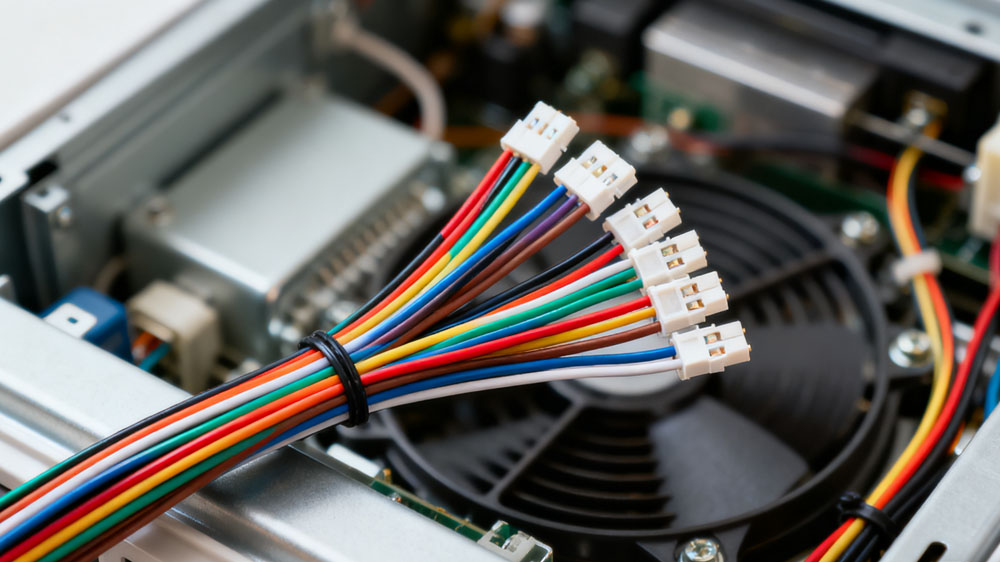Wiring harnesses, used in applications from automotive to industrial, organize cables and connectors to transmit power and signals efficiently while reducing clutter. This guide explores the different types of wiring harnesses and what makes each unique.

What is a Cable Harness?
A cable harness, also known as a wiring harness, is an organized set of wires, terminals, and connectors bundled together to transmit electrical signals and power within a system.
Instead of having loose wires running throughout a device or vehicle, a cable harness consolidates them, providing protection, ease of installation, and a cleaner design. The design of a cable harness considers factors such as the electrical load, environment, and required flexibility, making each harness tailored to its specific application.
Types of Wiring Harnesses
Wiring harnesses are categorized in multiple ways based on their design, complexity, and application.
Broadly speaking, the main types include:
- Automotive Wiring Harnesses: Designed for vehicles, these harnesses connect various components such as the engine, lighting, dashboard, and infotainment systems.
- Industrial Wiring Harnesses: Used in machinery, manufacturing equipment, and robotics, these harnesses handle higher currents and often feature protective shielding to withstand harsh conditions.
- Consumer Electronics Wiring Harnesses: Found in appliances, computers, and other electronic devices, these harnesses focus on compact design and precise connectivity.
- Aerospace Wiring Harnesses: Built to stringent safety standards, aerospace harnesses must endure extreme temperatures, vibration, and electromagnetic interference.
- Medical Device Wiring Harnesses: Custom harnesses designed to meet stringent regulatory requirements, ensuring reliability and safety in medical equipment.
Types of Wiring Harnesses by Operating Environment
The environment in which a wiring harness operates significantly influences its design and material selection.
Key classifications include:
Indoor Wiring Harnesses
Typically used in residential or commercial applications, these harnesses are designed for controlled environments with minimal exposure to moisture or extreme temperatures.
Outdoor Wiring Harnesses
Built to resist UV radiation, rain, and fluctuating temperatures, these harnesses are common in automotive, telecommunications, and outdoor machinery.
High-Temperature Wiring Harnesses
Used in areas like engine compartments or industrial furnaces, these harnesses are constructed with heat-resistant insulation and components.
Low-Temperature Wiring Harnesses
Designed to function in extreme cold, such as refrigeration units or arctic equipment, these harnesses maintain flexibility and conductivity at low temperatures.
Wiring Harness Applications
Wiring harnesses are used in a wide array of industries due to their ability to simplify complex electrical systems. Common applications include:
Automotive Industry
From connecting headlights to engine management systems, wiring harnesses streamline vehicle electrical systems.
Aerospace and Aviation
Ensuring reliable electrical connections in aircraft, spacecraft, and drones.
Consumer Electronics
Supporting power and signal distribution in appliances, computers, and entertainment systems.
Industrial Equipment
Connecting sensors, motors, and control systems in manufacturing plants.
Medical Devices
Providing precise electrical pathways for diagnostic and therapeutic equipment.
Benefits of Wiring Harnesses
Wiring harnesses offer multiple advantages. They help keep wires organized, which makes maintenance simpler, while proper insulation and routing reduce the risk of short circuits and electrical fires.
By creating streamlined pathways, harnesses improve signal transmission and installation efficiency. Additionally, they protect wires from abrasion, moisture, and chemical exposure, ultimately reducing labor and maintenance costs.
Why Choosing the Right Cable Harness is Important
Selecting the appropriate wiring harness affects the performance and lifespan of any electrical system. Choosing the wrong harness can result in malfunctions, signal interference, or safety issues.
Consider factors such as the operating environment, electrical load, regulatory requirements, and mechanical stress. Understanding the needs of your application helps ensure reliability, efficiency, and safety.
Conclusion
Wiring harnesses are more than just bundles of wires—they are essential components that organise, protect, and streamline electrical systems across industries.
From automotive to medical devices, selecting the right type of harness for your specific environment and application ensures optimal performance and safety. Understanding the types of wiring harnesses available helps you make informed choices that improve efficiency and reliability in any project.
 +86 138-6870-3133
+86 138-6870-3133 sales@lanzmfg.com
sales@lanzmfg.com EN
EN CN
CN Search
Search